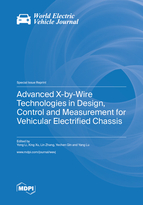Advanced X-by-Wire Technologies in Design, Control and Measurement for Vehicular Electrified Chassis
A special issue of World Electric Vehicle Journal (ISSN 2032-6653).
Deadline for manuscript submissions: closed (30 November 2022) | Viewed by 31626
Special Issue Editors
Interests: motor control and thermal management; vehicle dynamics and control
Special Issues, Collections and Topics in MDPI journals
Interests: vehicle dynamics and control
Interests: automated vehicle planning and control system
Interests: vehicle dynamics; autonomous vehicle
Special Issue Information
Dear Colleagues,
Advanced X-by-wire technologies for vehicular electrified chassis play an essential role in the development of new energy intelligent vehicles, which is the inevitable choice for intelligent vehicles in the future. This technology is involved in mechanical engineering, electronic and electrical engineering, computer technology, control engineering, signal processing, and artificial intelligence. Advanced electrified chassis control technology transmits control signals through cables and acts directly on the actuator to implement corresponding actions. The application of X-by-wire technologies for vehicular electrified chassis has changed the complex mechanical connections among actuators and hydraulic and pneumatic equipment in the past, greatly promoting energy efficiency, integration, and intelligence.
This Special Issue focuses on advanced X-by-wire technologies in strong reliability design, modeling, integration control, thermal management, energy management, fault diagnosis, and fault-tolerant control with the vehicular electrified chassis. Therefore, the aim of this Special Issue is to solicit recent advanced X-by-wire technologies for vehicular electrified chassis.
Topics of interest include but are not limited to:
- Modeling, analysis, control, and management of electrified chassis;
- Coordinated control of integrated chassis;
- Highly integrated design technology of electronic control suspension, steering by wire, braking by wire;
- High-efficiency motor drive control, thermal management, electric drive system design;
- Autonomous driving and intelligent linearization control technology;
- Testing and signal analysis technology of electrified chassis;
- Vibration and noise suppression;
- Reliability design and evaluation;
- System operation condition monitoring and fault diagnosis technology;
- Highly reliable fault-tolerant control technology.
Dr. Yong Li
Prof. Dr. Xing Xu
Dr. Lin Zhang
Dr. Yechen Qin
Dr. Yang Lu
Guest Editors
Manuscript Submission Information
Manuscripts should be submitted online at www.mdpi.com by registering and logging in to this website. Once you are registered, click here to go to the submission form. Manuscripts can be submitted until the deadline. All submissions that pass pre-check are peer-reviewed. Accepted papers will be published continuously in the journal (as soon as accepted) and will be listed together on the special issue website. Research articles, review articles as well as short communications are invited. For planned papers, a title and short abstract (about 100 words) can be sent to the Editorial Office for announcement on this website.
Submitted manuscripts should not have been published previously, nor be under consideration for publication elsewhere (except conference proceedings papers). All manuscripts are thoroughly refereed through a single-blind peer-review process. A guide for authors and other relevant information for submission of manuscripts is available on the Instructions for Authors page. World Electric Vehicle Journal is an international peer-reviewed open access monthly journal published by MDPI.
Please visit the Instructions for Authors page before submitting a manuscript. The Article Processing Charge (APC) for publication in this open access journal is 1400 CHF (Swiss Francs). Submitted papers should be well formatted and use good English. Authors may use MDPI's English editing service prior to publication or during author revisions.










